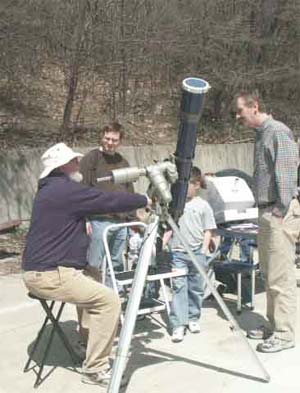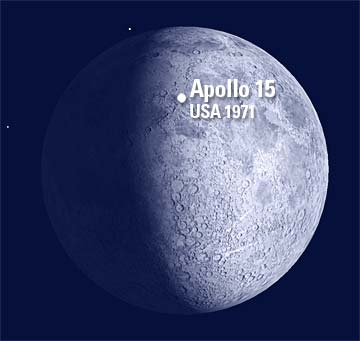
Astronomers, both amateur and professional, love sharing their passion for astronomy with the public. Observatories hold open houses, astronomy clubs hold star parties, but most of these events happen at fairly remote sites, where it's often hard to entice the casual visitor to attend. In 1973, Doug Berger in Northern California organized the first Astronomy Day with the idea of bringing astronomy to the public, rather than expecting the public to come to it. Events were held in city parking lots, shopping malls, anywhere people gathered. The idea quickly caught on, and Astronomy Day is now celebrated around the globe.
 Geoff Gaherty, at left, showing the Sun with his 120mm refractor at the RASC Toronto Centre's Astronomy Day event at the Ontario Science Centre in April 2004.
Geoff Gaherty, at left, showing the Sun with his 120mm refractor at the RASC Toronto Centre's Astronomy Day event at the Ontario Science Centre in April 2004.
Astronomy Day takes place on the Saturday closest to First Quarter Moon between mid April and mid-May; this year Astronomy Day is on Saturday, May 6.
Why April-May? Because from most places, it's a pleasant time of year for outdoor activities. Certainly, at the mid-northern latitude where I live, it's too cold any earlier.
Why first quarter Moon? Because the cratered surface of the Moon offers the most spectacular views. Keen amateur astronomers may enjoy hunting down faint fuzzies when the Moon is not visible, but someone who has never looked through a telescope before will have a hard time seeing even a bright fuzzy, especially from an urban light polluted location!
The planets are also popular targets, and we've got the best of the bunch, Saturn, well placed in our evening sky. Many Astronomy Day events take place during the day, when safe solar observing can be done.
How do you find out about Astronomy Day events? Gary Tomlinson of the Astronomical League maintains a web site summarizing all events for this year. If you want to organize an event yourself, there is an excellent guide book available.
The folks at Starry NightŪ have prepared a "Welcome Guide to Astronomy" that you can download for personal use or distribute to the public on Astronomy Day. It includes tips on how to get started, how to select a telescope and easy to read star maps. The guide includes an area on the cover for clubs to add their contact information.
What sort of events take place on Astronomy Day? Many clubs set up displays about astronomy and telescopes in malls, science centers, and planetariums. Many arrange to have well-known astronomers give talks. And, of course, there are lots of opportunities for people to look through telescopes at the Sun, Moon, planets, and whatever other objects are visible from urban and suburban locations.
When choosing objects to show people on Astronomy Day, you should concentrate on bright showpieces. It helps to decide ahead of time what objects you are going to show Then do a little homework so you can tell people a few interesting things about what they're looking at. All except the brightest galaxies elicit very little interest from the general public. Double and multiple stars, often overlooked by today's amateur astronomers, are often very interesting to the public, especially when you can tell them how far apart the stars are and how long they take to orbit around each other. Even such an obvious target as the Moon can be handled in different ways. I usually use a telescope with a motor drive and put a fairly high magnification on, so that just one area of the Moon's surface is shown in detail. Often I will focus on one of the Apollo landing sites, since that's a good conversation starter. This year the Apollo 15 landing site is particularly well placed on Astronomy day:

I wish you all clear skies and good observing on Astronomy Day!
April 2006
Geoff has been a life-long telescope addict, and is active in many areas of visual observation; he is a moderator of the Yahoo "Talking Telescopes" group.















